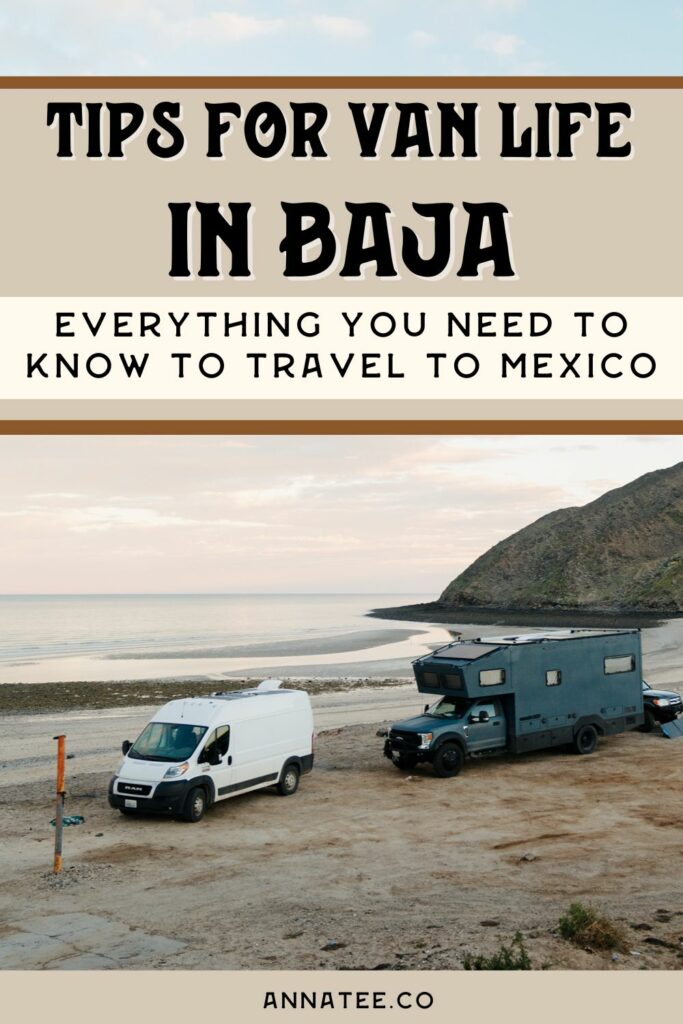Tips for Van Life in Baja
Baja is the perfect place to live in a van – free beaches, beautiful campsites, friendly people… the list could go on forever. If you’re used to living in a van in the US or in Canada, it can definitely feel intimidating to drive to Baja and take your van there, but it’s so worth it, and an incredible way to spend the winter! This guide will give you some tips for van life in Baja, from safety to where to camp to how to get water, and more!

Head’s up: some of these links are affiliate links, so I get a commission if you make a purchase (at no cost to you). But that’s great, because I was going to share anyway, and this helps me keep making free guides for you!

Table of Contents
Pin this photo to save this guide to van life in Baja and reference it later!
Is Van Life Safe in Baja?
One thing that I feel strongly about is the fearmongering that often happens in any discussion around van life in Baja, and just being in Mexico. I’m sure you’ve had the experience of telling someone that you want to visit, and had them gasp in horror and clutch their pearls.
Let’s be clear: most of this is simply racism. A lot of Americans see Mexico as this big, scary “other,” and it’s really important to check yourself and your biases. If someone speaks negatively about Baja, ask them if they’ve ever been. And if they have, ask them if they ventured outside of their resort. Most likely, the people who rant about cartels and corruption truly just don’t know what they’re talking about. Of course, that’s not to say that danger doesn’t exist in Baja – there isn’t a place in the world that’s 100% guaranteed to be safe.
Fearmongering is harmful and not okay, and I hope you don’t let it deter you from taking the trip. And listen, I’ve had the experience of being robbed at gunpoint (not in Mexico) – shit does happen. But, van life is safe in Baja.
Of course, there are things to watch out for, just like you would anywhere else. Lock your car doors, be aware of your surroundings, and read about the places you stay. If you feel uneasy, paid campgrounds can feel safer, since they’re more established and usually have other people around. Traveling with friends is also a good way to calm any nerves, and it’s fun!
Overall, Baja is a very safe place, and I have felt completely at ease during my trip.

The Best Time for Van Life in Baja
The best time for camping in Baja is definitely winter, as the weather is warm and sunny. Summer is definitely hot, so winter offers the best, most comfortable weather for van life, and for visiting Baja in general. Winter is also the most popular time to go, so expect to see plenty of other travelers!
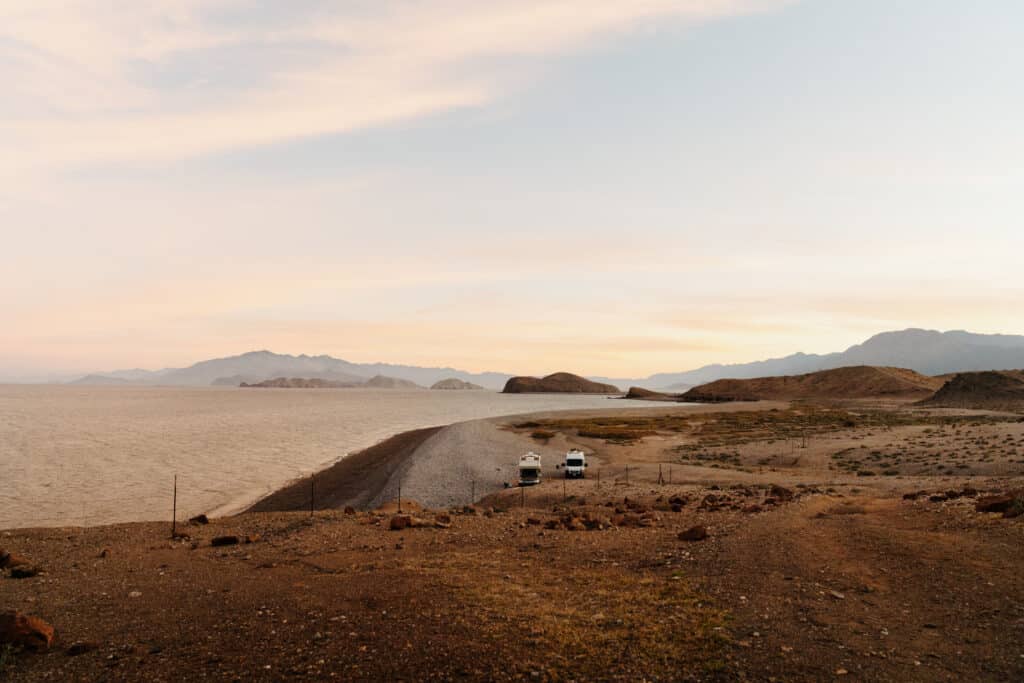
Preparing for Van Life in Baja
Before you take your van to Baja, there are some things you need to prepare!
Car Insurance
A Mexican car insurance policy is required for driving to Baja. By law, you at least need liability coverage – and US insurance policies typically are not accepted (though it may be worth calling your insurance company to check). Driving without insurance is illegal in Baja, and can get you in serious trouble if anything were to happen. Make sure you get insurance before you get to Baja!
The car insurance that I used for my Baja road trip was Baja Bound. They insure cars, camper vans (including self converted ones), motorcycles, RVs, and more – and the process is really quick and easy. You can get a quote online in minutes, and the prices are fairly reasonable.
If you’re going for more than about three weeks, it’ll likely be cheaper to get a six month policy – and this way you don’t have to have an exact date in mind for when you’re leaving Baja. I paid $363.50 (USD) for car insurance though Baja Bound, with a six month policy. I *knock on wood* haven’t had to use it, but have a few friends who have needed to in the past – and they have all said that their experience with Baja Bound was easy and that they were super responsive when it came to claims.
A few things to note about your Baja car insurance:
- Baja Bound only works on conventional roads (which is typical of insurance both in Baja and in the states). Beaches, off roading, and anything off of “real” roads isn’t covered.
- My US car insurance is through State Farm, and I was able to call them and suspend my US policy for the time I would be in Baja, saving some money. I definitely recommend calling your insurance company to do the same!
- Make sure to print out your insurance documents before your trip. You will need them if something happens, or if you’re asked for proof of insurance by a cop or at a military checkpoint.
Documents
There’s one document that you’ll need to get when you cross the border – the FMM (Forma Migratoria Múltiple). For more information on how to get that, check out this post about crossing the border!
Other documents that you should have include the ones you should have with you anyway, like your car registration and title, driver’s license, and passport. It’s also recommended to make copies of all of these, just in case. And if a police officer asks for any documents, give them a copy instead!
If you’re doing van life in Baja with pets, you will also need to print out their vaccine records. I know several people who brought dogs or cats to Baja who say they have never been asked for their records, but of course, it’s better to have them and not need them than the other way around.

Cell Phone Plan
It’s also a good idea to look into cell phone plans before you go. Check with your carrier to see if your current plan will work in Mexico. I have Mint Mobile, which allows you to buy roaming credits as needed. This is perfect for me, since I planned to mostly use the Starlink for wifi, and just have the roaming option available if I needed it.
Offline Maps
One great thing to do before you leave for camping in Baja is to download offline maps. You can do this in Google Maps, and it allows you to get directions when you don’t have service – which is pretty often in Baja.
Google Translate
One great thing about the Google Translate app is that you can actually download a language, and be able to translate things without service! So before you leave for Baja, download Spanish just in case you need it.

Things to Bring for Van Life in Baja
Traction Boards
Recovery boards are important for getting out of the sand! If you get stuck on a beach, these help a ton. I bought some cheaper off brand ones, and have used them a few times and they’ve worked well and held up just fine. But, MaxTrax are typically the recommended option and likely would last longer.
Tire Stuff
Another great tool for driving on the beach is the ability to air down your tires. This increases traction, and helps you drive on soft sand. Having a tire deflator allows you to do that, and then you’ll need an air compressor to reinflate your tires!

Starlink
You don’t need a Starlink of course, but there’s minimal service in Baja, especially once you get away from the big towns. If you’re working during your trip, this is definitely the best way to ensure Internet access.
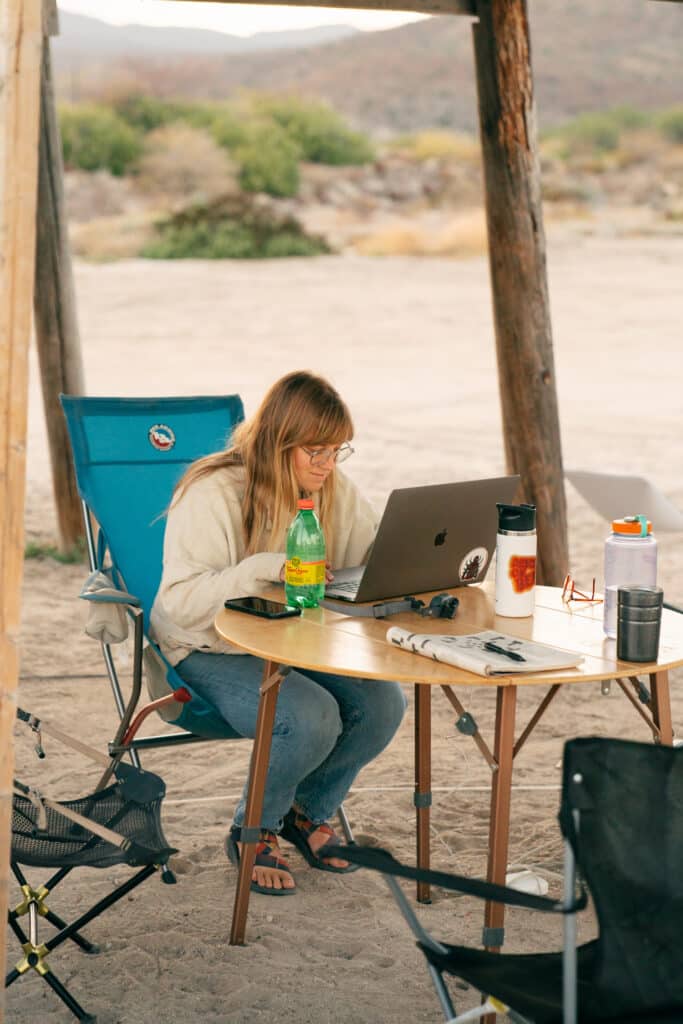
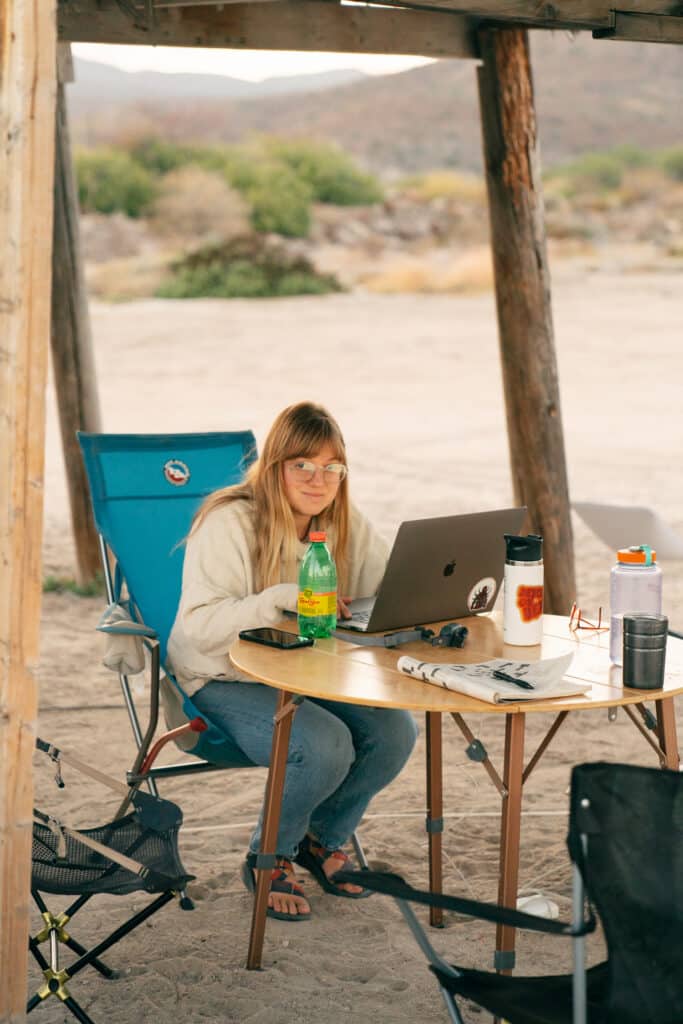
Walkie Talkies
Walkie Talkies are super useful for caravanning, as it lets you communicate about pit stops, hazards, and anything else you might encounter. If you’re traveling with friends, these are great to have, and also really fun!
Police and Military Checkpoints in Baja
Two of the biggest concerns about van life in Baja are the police, and military checkpoints.
Police
It’s not uncommon for police to stop vehicles and ask for a bribe. They will usually tell you that you can pay the ticket, or give them the money, which will cost less than the ticket. You can give them some money (don’t carry too much cash in your wallet at once – have like, 200 pesos, and keep the rest somewhere else), but you can also ask them to take you to the police station to pay the ticket. They usually won’t do this, because they can get in trouble for trying to get a bribe from you. If they do decide to take you to the station, you’ll need to give them your driver’s license and follow them. Bribing them isn’t recommended, as it does kind of perpetuate the practice, but of course it can definitely be scary to have a police officer at your door, so I get it if you decide to just give them a few pesos and go on your way.
One person in my group has had an encounter with the cops – he was pulled over and told he missed the stop sign, but all he did was argue that he did actually stop, and the police let him go and drove off. I think it probably also helped that the three of us who were driving in front of him turned around and stopped across the street when he got pulled over.
Most shakedowns happen close to the border, so I recommend not stopping anywhere after crossing and just keep going to your destination. Drive carefully and don’t give the police a real reason to stop you.
Military Checkpoints
A lot of people get intimidated by the military checkpoints, but they truly are nothing to worry about. At most military checkpoints, I was simply asked where I came from and where I was going, and then waved on. There were a few times where I was asked to open my door, but I haven’t had anyone actually search my van. If they do search your vehicle, they’re looking for illegal goods, like drugs and weapons, but obviously you shouldn’t have those with you. The most notoriously difficult checkpoint is between Guerrero Negro and San Ignacio, and a lot of people say their vehicles were thoroughly searched – but I was just waved on at that one.
If you do get searched, stay close by and keep an eye on your things. I do have a friend (who wasn’t traveling with me) who had a few things stolen from the cab while he was in the back with another officer, so don’t leave things unattended. One tip that I’ve heard from others is that if you have a speaker, you should hide it – for some reason some military officers seem to want to take them?
Tip: Spanish has two forms of “you” – the informal tú and the formal usted. Using usted (like busting out a “Cómo está usted) when you pull up to the checkpoint) with military officers as a sign of respect seems to make them happy. Also, though most of the guards I’ve encountered do speak enough English that you would be fine speaking it, I’ve gotten the feeling that speaking Spanish to them makes them think a little more fondly of you. And of course, you are in their country, so if you’re able to, brush up on your Spanish and use it!

How to Get Water for Van Life in Baja
Living in a van means filling your water tank – but tap water in Baja is not potable! It’s not a good idea to drink tap water in Mexico, and you should even be careful about getting ice in drinks. Most places don’t have the infrastructure to separate contaminants from water, so it can make you sick (side note: when using public toilets in Mexico, you typically are supposed to put your toilet paper in the trash instead of flushing it).
But, don’t worry, there are plenty of places in Baja where you can find potable water – Agua Purificada. I use the app iOverlander, which has many water places marked. Some places are only able to fill jugs, so if you need a hose connection to fill your water tank (like I do), read the reviews to find a place.
Filling up at these places is easy, and inexpensive. It usually costs just a few cents per liter. That’s another thing – before filling, you might be asked how many liters you need, so if you’re used to using gallons, make sure you do the conversion for your tank.
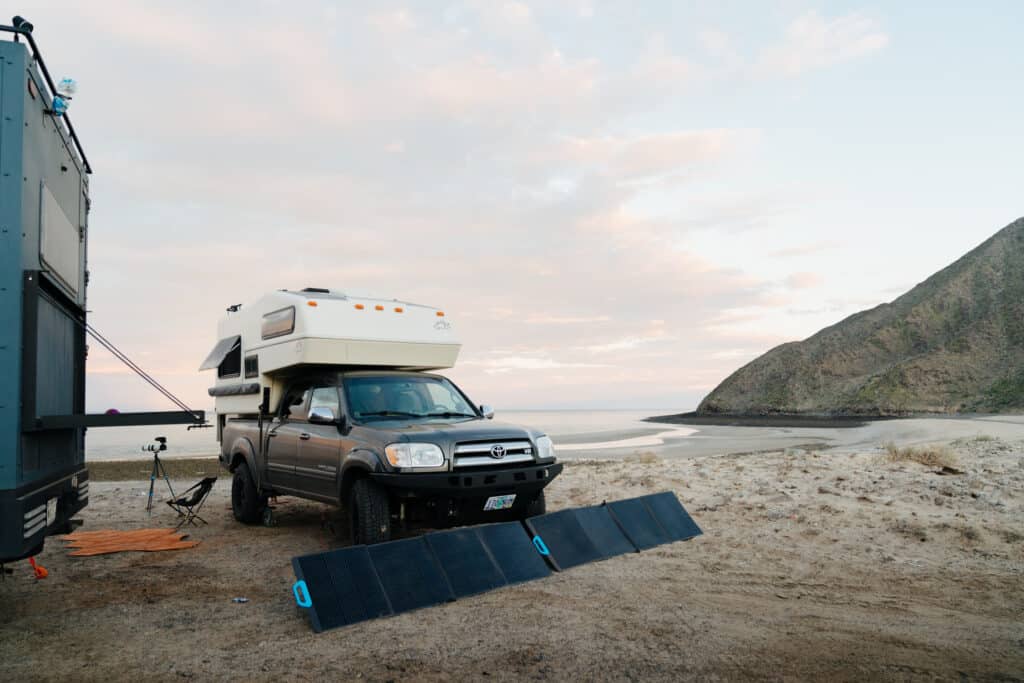
Where to Throw Out Trash for Van Life in Baja
Another typical van life task is finding places to put your trash. I’ve found that unlike the US, there aren’t very many trash cans and dumpsters around Baja – the gas stations don’t even have trash cans, so it can be a little more difficult to find a place to throw things away.
Many paid campsites will have trash cans, and at free sites, there are sometimes locals who will come by and ask if you need your trash taken – for which they’ll ask for a few pesos. Otherwise, just keep an eye out for public trash cans!
Groceries in Baja
You won’t have any trouble finding something to eat in Baja, but some places are pretty remote and have very small, expensive grocery stores. It’s a good idea to stock up on some staples before you leave the US (no produce or meat though, as this can’t be brought over the border), like your favorite Trader Joes snacks or some milk alternatives.
When you’re in Baja, stock up on groceries whenever you’re in a bigger town – these stores will have more options, and won’t be as expensive.
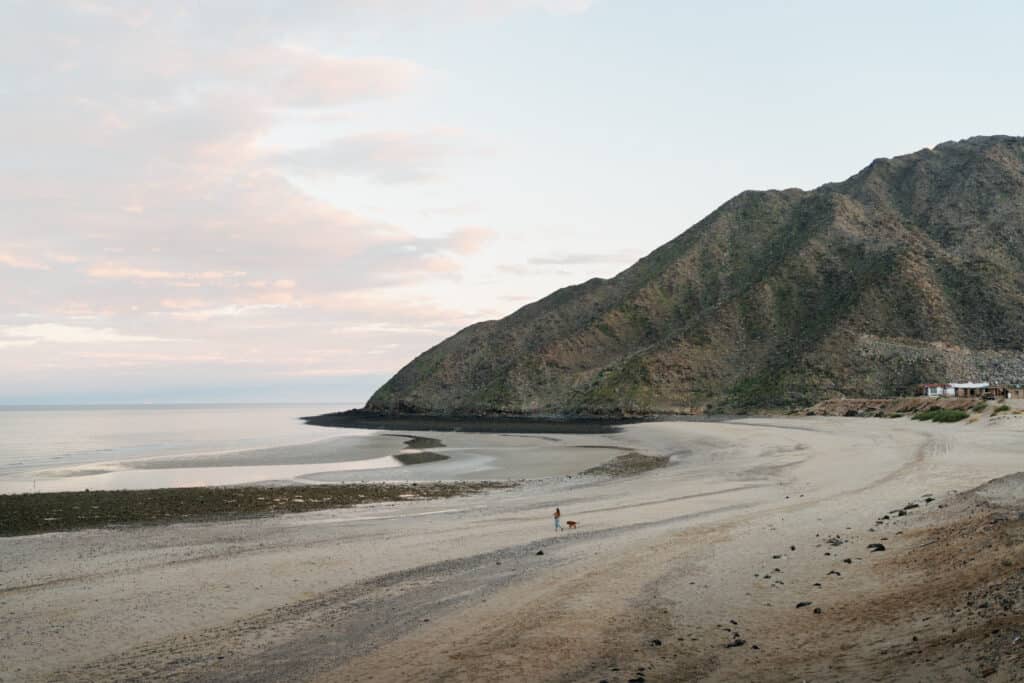
Getting Gas for Van Life in Baja
It’s always a good idea to keep your tank pretty full when you’re driving through Baja. There are some stretches where there are no gas stations for a while, and sometimes those small gas stations can even be out of gas. Finding diesel can sometimes be more of an issue, as not all gas stations have it.
Also – in Mexico, diesel handles are black and gas handles are green, which is the opposite of how they are in the US. Double check the labels before you start fueling!
Most gas stations in Baja are not self serve, so you will have someone filling the gas for you (“lleno” is the word for full, by the way). Always check to make sure that it’s at zero before they start filling your gas, because at some gas stations it’s a fairly common scam to get more money out of you. Many of the attendants will actually point and confirm before they start that it is at zero.
Gas can get pretty expensive in Baja, so you can expect prices similar to what you’d find in California.
Tips for Driving in Baja
Van life in Baja of course includes a lot of driving – so here are some tips for navigating the roads.
The Roads in Baja
I’ve heard horror stories about how terrible the roads are in Baja, but honestly, I’ve found them to be pretty mild. But, I haven’t gone all the way south quite yet, so maybe I’ll update this post in a month.
In general, the highways are pretty narrow – I can definitely see how it might be stressful if you have a bus or an RV! But, for my Ram Promaster there haven’t really been any roads where I felt uneasy at all. There also isn’t much of a shoulder most of the time.
There are also some spots with more potholes, so you might find yourself swerving (safely!) around them, but again, it’s nothing too terrible at all.
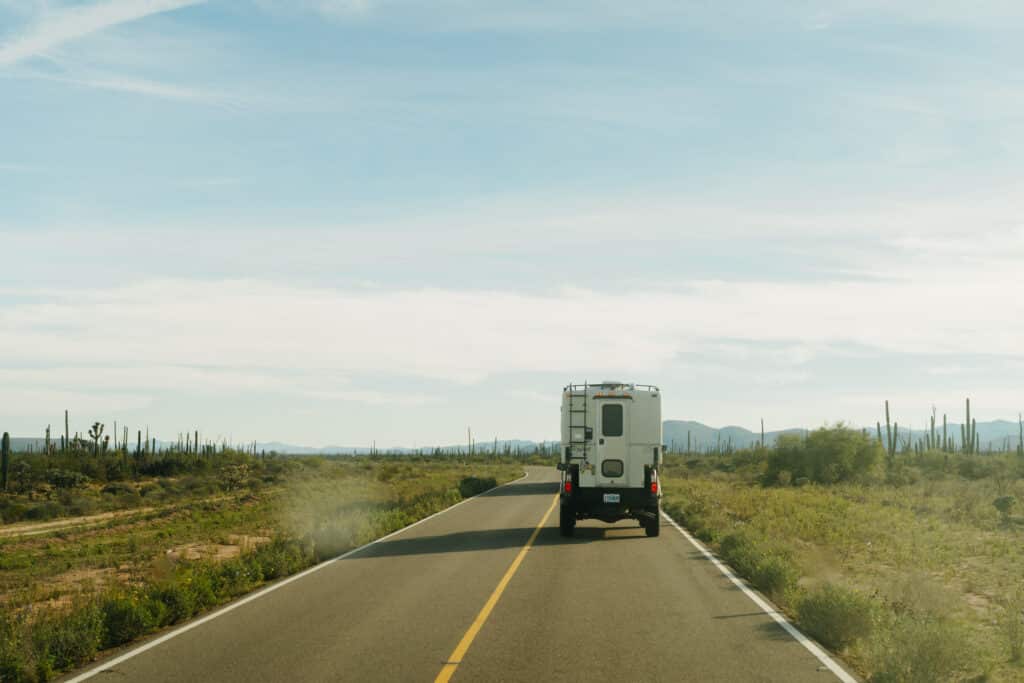
Passing Other Cars
In Baja, cars often pass each other on highways. If you’re driving behind someone and they start flashing their left turn signal, that means they’re indicating that it’s safe for you to pass. You can also do the same for people driving behind you, but of course make sure you have a clear line of sight and are sure that it’s safe to pass you.
Driving at Night
In general, the rule of thumb for driving at night is – don’t. There are often animals in the road, and it’s harder to see potholes. So, try to only travel during the day.
The Green Angels
Save the number for the Green Angels! This is a program similar to AAA in the US, and they provide free travel info and mechanical assistance for anyone driving in Mexico. They also speak English. Save their number in case you break down in Baja! It’s 078.
Getting Stuck on Beaches
Getting stuck in the sand seems to be sort of a rite of passage for van life in Baja, so just make sure that you’re prepared to get yourself out! Have traction boards, and ideally you should also travel with someone who has 4×4 and can pull you out :-). But if not, locals are super nice and you’ll be ok!
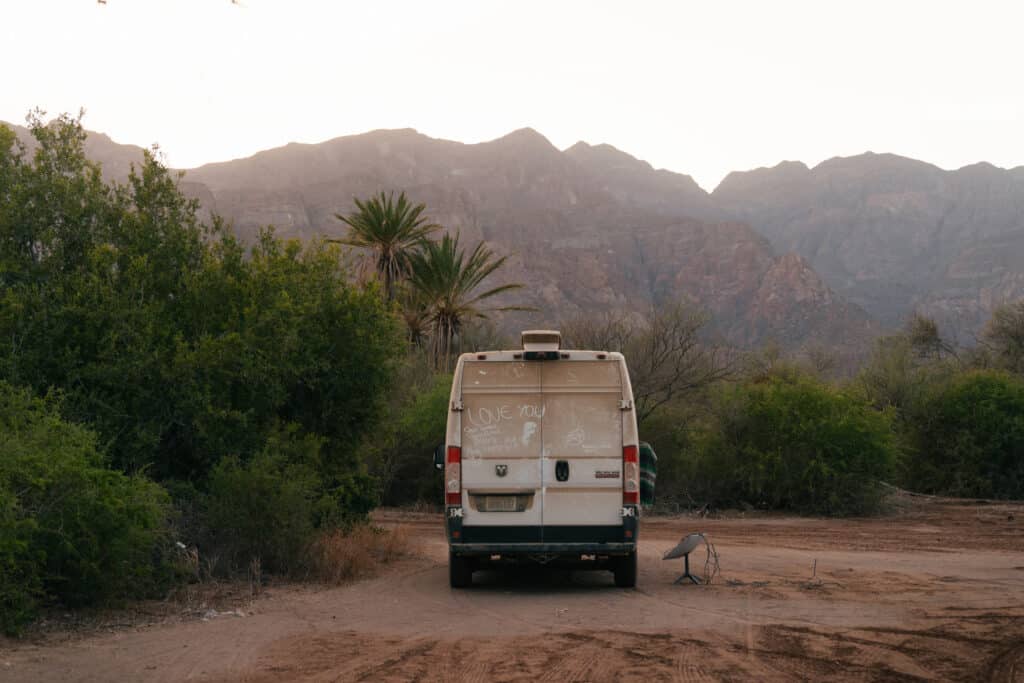
Do You Need to Speak Spanish to Do Van Life in Baja?
In general, the answer is no. A lot of people in Baja speak English, or at least enough English that at a military checkpoint or at the gas station you’d be fine without knowing any Spanish. But, it’s still a good idea (and it’s respectful) to learn some basic vocabulary or to write down any phrases that you might need to know. I speak Spanish decently well thanks to 5 years of it in school, and I do feel like even though English is pretty widely spoken in Baja, speaking Spanish as much as possible when you talk to locals is not only helpful, but it’s just kinder when you’re a visitor in someone else’s country. Everyone I’ve talked to has been totally willing to help me fill in a word I don’t know (if you want to ask, say “Cómo se dice __ in Español”), and they seem to appreciate the effort. So even if you don’t speak a lot of Spanish, what matters is that you try!
Dogs in Baja
Another thing to know about van life in Baja is that it’s much more common to see of leash dogs around. Any time you’re in town, and often even at campsites, you’ll see dogs wandering.
Don’t assume that every dog you see is a stray – dog culture is different here than in the US, but, there are definitely street dogs too. I’ve had a lot of dogs come up to me, and most seem to be very friendly (I imagine the ones that don’t like people just stay away), but this is definitely something to be aware of if you have a dog of your own, especially one who is reactive.
When you drive, watch out for dogs in the road – but, the dogs that live here tend to be smart when it comes to avoiding cars. Another concern might be your own dog – because the dogs in Baja usually avoid cars, some drivers don’t look out for them in the road. If your dog isn’t used to that and doesn’t know not to run out into the road, be careful having them off leash.
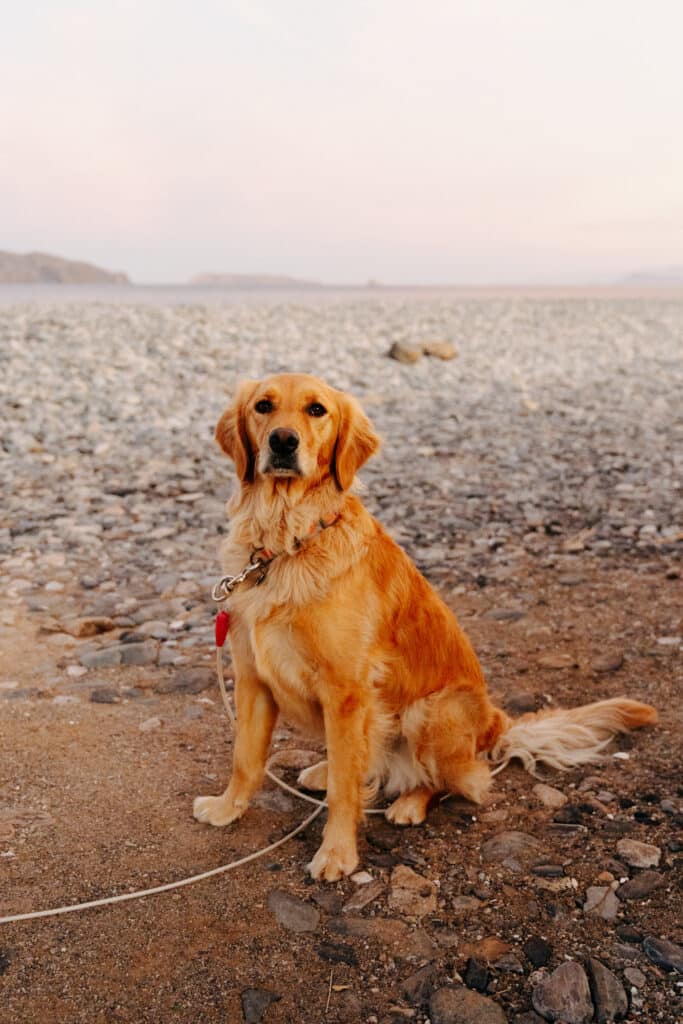

Where to Stay When You Van Life in Baja
When you van life in Baja, you have tons of incredible options for where to park. In general, it seems like towns are actually friendlier towards van dwellers than many places in the US, and there are a lot of options for beautiful campsites.
Free Camping
There is so much gorgeous free camping in Baja. In a lot of places, you can park right on the beach and enjoy the views, all for free! Some places are definitely harder (or impossible) to reach without 4×4, but I was in a FWD Promaster van for my Baja road trip, and had no problem getting to some incredible spots. I’m a big fan of free camping over paid sites, but paying for a spot can get you some amenities.
My favorite way to find free campsites in Baja is iOverlander, which is an app where users can contribute locations. It’s great because people can leave reviews, so that you can be prepared and know if a spot is 4×4 only.
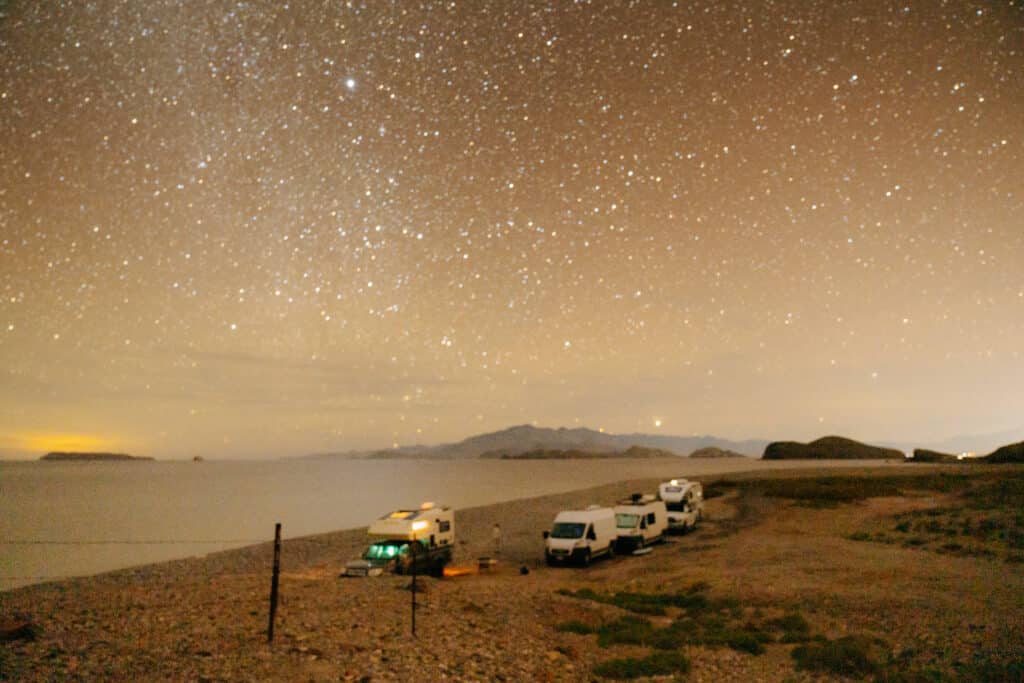
Paid Campsites
Another option for places to stay in a van is paid campsites. These might have amenities like toilets, showers, and wifi, and some people feel safer staying at paid sites. These can definitely vary – some campgrounds have flushable toilets and showers, while others might just have a pit toilet.
Campsites in Baja tend to be about $10 – $15 USD per night, though RV parks are more pricey. Campsites are first come, first serve, and usually will only take cash – if you have the option, I always recommend paying in pesos rather than USD, as it will be a little cheaper. You can find paid campsites on iOverlander as well, and the reviews will usually tell you exactly what to expect!
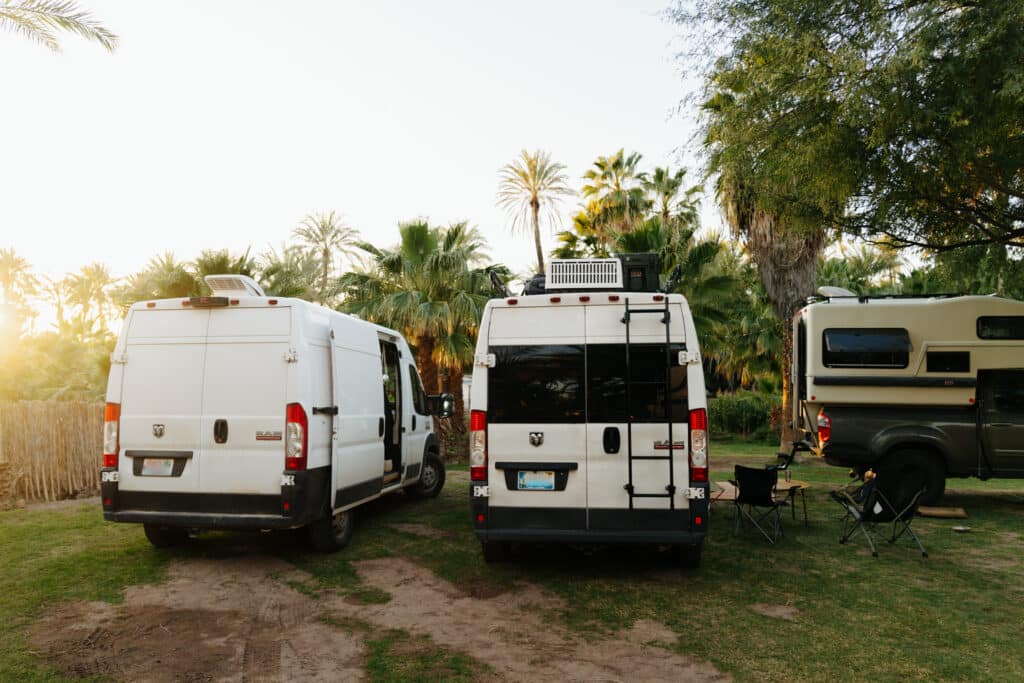
RV Parks
RV parks can be a good option if you need electrical hookups, and these parks often have amenities like restaurants or pools. One thing to be aware of is that many of them have water, but it isn’t potable – so make sure to ask if you aren’t sure, because drinking tap water in Mexico is definitely not advised. These tend to cost $25-$50 per night.
Ready for Van Life Baja?
Baja is truly magical, and I can’t think of a better way to spend the winter. If you have any tips of your own, or questions about van life in Baja, let me know in a comment below!
For more Baja resources, check out this guide to camping in Baja, and this one about crossing the border. To plan a road trip, here’s a Baja road trip itinerary that covers the entire peninsula!
Pin any of these photos to save this guide to van life in Baja for later!

